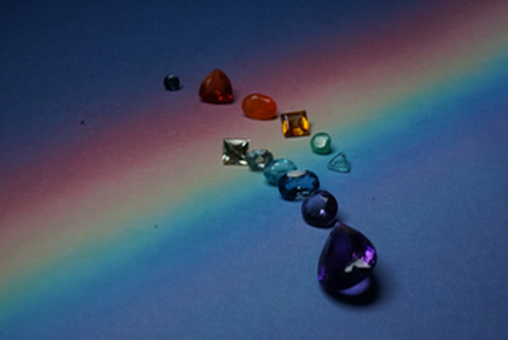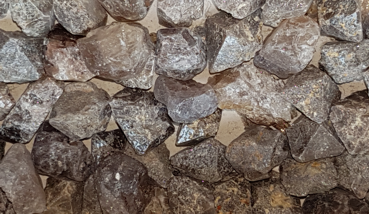The Stones in The Wall of The Heavenly Jerusalem
Gemstones of the heavenly Jerusalem
The stones are chosen according to the colors of the rainbow. Only crystalline stones have been selected so that the brilliance and beauty of such treasures can be seen. You will not find a diamond in the picture, because it does not belong to the stones mentioned in Revelation 21.

Attention: If we also used crystalline stones, then we must draw attention to a systhematics in the enumeration of the stones: Their order is marked by an essential character. There are changes from opaque to translucent or transparent stones. Also for this reason the first stone cannot be a diamond, because from the systematics it becomes recognizable that the first stone must be opaque.
Diamond or living stones for building
1 Peter 2:5 "Be yourselves also as living stones, built up, a spiritual house, a holy priesthood, to offer spiritual sacrifices, pleasing to God through Jesus Christ".
"Constructed into living stones", what an ingenious thought, especially when you look at the beauties that exist in creation. The creativity and ingenuity of God can be seen in every single object, every stone is unique and beautiful in its individuality. All love and the effort of the Lord associated with it becomes visible through every detail, no matter how small.
In the wall of the new Jerusalem 12 stones are seen. How were the stones made?
In short, this is a lengthy and costly process in the interior of the earth. Silicates are enriched with a wide variety of minerals and, under the influence of heat and pressure, form gas bubbles or even liquid veins in the rock interior and undergo periods of cooling and heating under constant pressure. In various stages an opaque stone grows into a crystalline one. At the end of a long period of time, the most valuable form clear and finest crystals, which we then find in individual druses, stone veins and stone mines.
Influencing factors on the development of the stones
During many thousands of years the stone grows steadily and changes due to external influences.
Even minor changes in the environment have an effect on the stone and influence its development. For example, take a simple gemstone, the trained amethyst. If it continues to be exposed to heat, it changes colour from violet to yellow. It is then classified as citrine. A second example: An additional addition of iron to jasper decides whether it remains a "yellow" or becomes a "red" one. If we expose the yellow jasper to great heat, in nature this happens through a volcanic eruption, it can even become a "crystal clear jasper".
In 1 Corinthians 1:28 Paul writes: "The base of the world - the pebbles - and the despised - the pebbles - God has chosen. These stones are now exposed to the influences of the world to become gems.
Growth
Christians go through such processes in a similar way. But due to the heat of the day and the pressure of the enemy, they remain in the place determined by God. On his construction site he redesigned it and in the end a pebble became a living and unique gemstone. This is what Paul wrote in 2 Corinthians 5:17: "If anyone is in Christ, there is a new creation; the old - the pebble - has passed away, behold, all things have become new - a precious stone. This new creation is no longer reversible.
Just as no chemical process can transform back into their original form the components of the gems called for the wall of heavenly Jerusalem, it is impossible to restore the new creation that we have become through Christ. Our new creature in the Lord is permanent so eternal and what is still important, it is unique.
A diamond lacks uniqueness
Preliminary remark:
Our descriptions should be kept quite simple, therefore we do not explain any complex processes at this point.
A diamond is an element solidified from approx. 99 percent carbon. At great depth, from approx. 60 km, the carbon escapes from the graphite under heat and is deposited on a "diamond germ". As long as the graphite releases carbon, the stone grows layer by layer.
The carbon, in the form of graphite, has a grey to black crystal structure, is opaque and has a metallic luster and very low hardness. Another material contains carbon, it is the ash remaining after combustion. Now quite simply: graphite can be made from ash, but even more: a diamond can be made from it, with a lot of effort and also not flawless, but at least with sufficient pressure and heat it becomes a diamond. But beware, such a process can also be reversed with a lot of energy and then the diamond becomes simple carbon (-dioxide) again.
What fundamentally distinguishes the diamonds from the stones in the wall of heavenly Jerusalem is that all diamonds have the same structure and appearance. They lack the individuality that today is somewhat pushed into the background by the polish. Without light, a diamond looks as colourless as ordinary glass.
In Greek or Latin the diamond was given the property of the "invincible", a property which is not entirely true. If we supply sufficient energy, the stone is transferred to its original state, the carbon. Now there is another very simple method to make such a precious stone worthless, as the Bible tells us.
Let's take a closer look at the stone that the translators identified as diamonds. The Hebrew word for stone is Jahalom - יהלום - and literally means "precious stone" in the sense of hardness, scaldness, insensitivity. It derives from halam with the meanings:
- knock down,
- hammering; stamping, trampling; conquering, defeating, subjugating; dissolving.
A diamond like that, if it is, we'll find it three times in the Bible.
- Exodus 28, 18 and the second row: carbuncle, sapphire and diamond;
- Exodus 39, 11 and the second row: carbuncle, sapphire and diamond;
- Ezekiel 28, 13 You were in Eden, the Garden of God; all kinds of precious stones were your cover: sardis, topaz and diamond, chrysolite, onyx and jasper, sapphire, carbuncle and emerald and gold. The work of art of your tambourine and your pipes was with you, on the day you were created they were prepared.
The stone, called Jahalom, may seem precious in the eyes of men, but the meanings it carries in the Bible speak less of its preciousness than of it as the means of choice to execute judgment.
Genesis 4:22 tells us about Zilla, the second wife of Lamech: And Zilla, also she gave birth to Tubalkein, a hammer of all kinds of cutting tools of ore and iron. And Tubalkain's sister was Naama.
Tubalkain is a hammer maker so a blacksmith. The Hebrew word for hammer is the verb latash with the meaning: a border, edge, edge hammer or sharpen. Now the word can also refer to the processing of a rim and thus points to the globe.
Now we take a closer look at the tool. Judge 4:21 mentions the hammer: "And Jael the wife of Heber took a tent peg and took the hammer in her hand, and she came quietly to him and struck the peg through his temple, so that it penetrated into the earth. He had fallen into a deep sleep and was tired, and he died."
The Hebrew word for hammer is Maqqebeth and means: perforator, like a hammer that pierces. The word describes further possible uses of the tool:
- Working in a quarry,
- hunting a game,
- kill a victim.
The word root of the hammer is nagaw. It describes the operations performed with the hammer:
- Pierce first,
- prick,
- perforate.
It looks like the hammer is used to make similar tools that are needed for other work, such as a sword or spear. If Jael reaches for the peg, it is a nail, then she drives the nail with the hammer through the temple of Sisera. Jael was trained in the use of the tools and so she smashed the head of Sisera and pierced his temple. The hammer that Jael uses, Hebrew Halmuth, is derived from the word "halam", which we already know and which also forms the root of the diamond. If the diamond is described as valuable, it is in the sense that it is the adequate tool to shatter the diamond, breaking it into thousands of pieces.
A diamond can only be machined with one diamond. On the allegorical level, it is the wife of a Hebrew who overpowers the invincible. Prophetically, Heber's wife points to the righteous from Romans 16:20: "But the God of peace will trample Satan under your feet in a short time. Why is the verse introduced with the expression "God of Peace"? Because the adversary who travels the world as a troublemaker will be defeated and the desired peace will spread throughout all creation, and because Jael is the wife of Heber, she must be a Hebrew, and we find her described in the letter to the Hebrews.
In Malachi 4:3 it says about the wicked, "And ye shall tread down the wicked, for they shall be ashes under the soles of your feet in the day which I shall make", saith the LORD of hosts.
After the enemy is shattered, the diamond is no longer needed. The instrument with which also the Antichrist is shattered has no place in the wall of the heavenly Jerusalem, because the stones that are to be seen there speak a different language. They talk about the Messiah and what he has become for us, but they also tell us about the sufferings of the faithful, how they, like their Lord, have become such precious stones.
Revelation 21
And I saw a new heaven and a new earth; the first heaven and the first earth had passed away, and the sea is no more. And I saw the holy city, the new Jerusalem, coming down out of heaven from God, prepared as a bride adorned for her husband. And I heard a loud voice from heaven saying, Behold, the tabernacle of God among men! And he will dwell with them, and they will be his people, and God Himself will be with them, their God. And he shall wipe away every tear from their eyes, and death shall be no more, neither mourning; neither crying, neither sorrow; for the first hath passed away, And he that sat on the throne said, Behold, I will make all things new. And he says to me, Write, for these words are certain and true. And he said unto me, It is done. I am the Alpha and the Omega, the beginning and the end. I will give to the thirsty from the spring of the water of life in vain. He who overcomes will inherit this, and I will be God to him, and he will be Son to me. But to the cowards and the unbelievers and the abominable and the spotted and the murderers and the whoremongers and the sorcerers and the idolaters and the liars, their part is in the lake that burns with fire, which is the second death.
And there came one of the seven angels which had the seven bowls full of the last seven plagues, and spake unto me, saying, Come, I will show thee the bride, the wife of the Lamb. And he led me away in spirit to a great and high mountain, and showed me the holy city, Jerusalem, coming down out of heaven from God; and it had the glory of God.
And it had a great and high wall, and it had twelve gates, and at the gates twelve angels, and names written thereon, which are the twelve tribes of the sons of Israel. To the east three gates, and to the north three gates, and to the south three gates, and to the west three gates. And the wall of the city had twelve foundations, and in it twelve names of the twelve apostles of the Lamb. And he that spake unto me had a measure, a golden reed, that he might measure the city, and its gates, and its walls.
And the city is square, and its length is as great as its breadth. And he measured the city with the reed, twelve thousand stadiums; the length and the width and the height thereof are equal. And he measured their wall, 144 cubits, a man's measure, that is the angel's.
And the building of their wall was jasper, and the city pure gold like pure glass. The foundations of the city wall were adorned with every precious stone:
- the first foundation Jasper
- the second Sapphire
- the third Chalcedony; the third Chalcedony;
- the fourth Samaragd;
- the fifth, Sardonix;
- she sixth, Sardis;
- the seventh, Chrysolite;
- the eighth Beryl;
- the ninth, Topaz;
- the tenth, chrysoprasm;
- eleventh, Hyacinth;
- the twelfth, Amethyst.
And the twelve gates were twelve pearls, and one of the gates was of one pearl: and the street of the city was pure gold, as transparent glass. And I saw no temple in her, for the Lord God Almighty is her temple, and the Lamb.
And the city does not need the sun, nor the moon, that they may shine on it; for the glory of God has enlightened it, and its lamp is the Lamb. And the nations will walk through her light, and the kings of the earth will bring her glory to her. And their gates shall not be shut by day, for night shall not be there. And the glory and honor of the nations will be brought to her. And there shall not enter into them any evil thing, or any abomination, or any lie, but only those which are written in the book of the life of the Lamb.
The heavenly Jerusalem and its building materials
Two thousand years ago, the Messiah Jesus became the cornerstone for the peaceful foundation of the heavenly Jerusalem. Now it is also called the new Jerusalem, but it is not really new, but, as the Greek word kainos and also its root neos let us know, completely renewed. In other words, the Bride of the Lamb, portrayed as a city, appears in youthful freshness.
The city consists of a precious material comparable to a crystal clear jasper. The Wall City is not a jasper, but its appearance resembles a jasper and also its character resembles this beautiful gemstone.
The gemstones of the wall in detail
We remember that the stones will adorn the wall of the heavenly Jerusalem. Now there are the most different colors of all stones. In the first picture, see above, we have chosen the colors of the stones according to the order of the colors of the rainbow. Their qualities speak of the treasures of the Messiah, the Son of God, who is at the same time man. They also symbolize the faithful who have become more like their Lord.
The stones undergo a slow transformation over a long period of time. During this time, certain trace elements are added and act on the starting material through heat and pressure. If the stones are excavated, we get unsightly rock for the time being. Only a trained eye can recognize a simple pebble from a gemstone. The following pictures are almost all taken in Idar-Oberstein. Both the Museum of Mineral Stones and the Museum of Gemstones allow photography. We can highly recommend a trip to the country of the German Gemstone Road.
By the way, with such a pebble David brought down the Philistine and killed him with his own weapon.

Picture 2: Rough diamonds
| LINK | Property |
| Jasper | opaque | |
Sapphire | transparent | |
Chalcedony | opaque | |
Samaragd | transparent | |
Sardonix | Sardonix | opaque |
Sardis | Sardis | opaque |
Chrysolite | Chrysolite | translucent |
Beryl | Beryl | transparent |
Topaz | Topaz | translucent/transparent |
chrysoprasm | chrysoprasm | opaque |
Hyacinth | Hyacinth | transparent |
Amethyst | Amethyst | transparent |
P.S.: We recommend the TOR browser because it makes surfing safer and the DuckDuckGo.com search engine because it actually shows more and better search hits.







